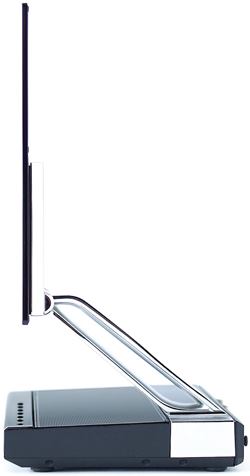The transition to digital television is just around the corner, and it’s clear that the age of HDTV will be thin, wide and very, very flat. The 4-inch-thick TVs that once separated the haves from the have-nots are now readily available to anyone with a Costco card. That’s good news for homeowners because it’s no longer just the primary TV in the home that’s getting a digital facelift. Come February every TV in the house has to have a digital solution.
A lot of TV makers want a slice of that pie, and the familiar brands are facing competition from low-cost options from China and elsewhere. Established brands including Hitachi, Panasonic, Samsung, and Sony are being challenged on price by upstart companies such as Vizio, leaving veteran brands scrambling to come up with advanced features that set their products apart from the pack.
The assortment of new features for 2008 TVs indicates a few of the new directions high-end TVs will take. Some are making a design play, showing curved displays, extremely thin panels, and bold accent colors. Others are going higher tech, using an Internet connection to enable users to multi-task in case hundreds of channels of TV aren’t compelling enough. Still others are doubling as photo frames, showing slideshows of homegrown digital photos or digitized versions of the masters so that the massive wall space devoted to a 50- or 60-inch TV isn’t dormant when the TV is dark.
As TVs grow in screen size, they add weight. In general plasma TVs are heavier than comparable LCD TVs but both have to fit the same rules, according to Ryan Hagberg, marketing manager for Sanus Systems, a supplier of TV mounts and entertainment furniture. “Any framed wall should be able to hold the weight of a mounted TV,” he says, “but you need to make sure that the wall will provide a secure surface for the TV to hang on.”
Knowing which material supports the wall is key. “Cement, brick, or steel construction can only support low-profile and tilting mounts,” says Hagberg. “Full-motion mounts increase stress on the bolts exponentially as they are pulled away from the wall. Wood studs are required for full-motion mounts,” he says. Rule of thumb: Walls must be able to hold five times the weight of the items that are to be mounted to it. When dealing with steel studs, like those typically found in commercial or condominium buildings, a special add-on kit is required.
Even with proper installation, the mount can shift later on, Sanus research shows. “We found that installers may have a mount perfectly level, but when they hang the TV and stand back they notice that the trim in the room isn’t level because the home has settled,” he says. Typically, that would require installers to redo some of their work in order to make the mount appear level. New technology on Sanus tilting and low-profile mounts enables installers to perform post-installation height and leveling adjustments quickly.
The 4- to 6-inch-deep TV was de rigueur when plasma TVs first came on the scene, providing a stark contrast to the bulky tube TV. But those early flat panels look stocky today compared with the latest designs that shave as much as a third off the depth of older flat screens. Hitachi’s 2008 flat panels are marketed as 1.5 in reference to the 1.5-inch depth of its advanced LCD and plasma TVs. Pioneer has lopped 20 percent off the depth of its plasmas to 3.7 inches.
Sharp, Samsung, and other companies are also banking on the ultra-thin LCD concept, while Sony began selling this year an 11-inch TV using OLED technology (organic light-emitting diode) that’s far thinner than previous technologies. Although the first-generation Sony OLED cabinet measures nearly 6 inches deep, the panel itself is 3 millimeters thick. The size and light weight, along with high brightness, may make OLED a formidable flat-panel competitor in the future for LCD and plasma. Samsung showed prototypes of OLED at the Consumer Electronics Show in 14- and 31-inch screen sizes with plans to introduce ultra-thin TVs as early as 2010.
Super-thin TVs show well in the home, but they present a challenge to builders and installers. Consumers buying a 1.5-inch-thick TV don’t want to see several inches of mechanics behind the screen. “As TVs become thinner, consumers also expect them to be closer to the wall,” says Hagberg of Sanus.



